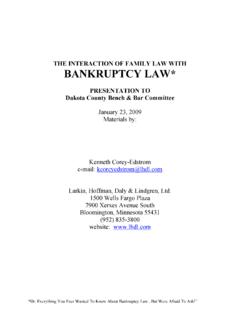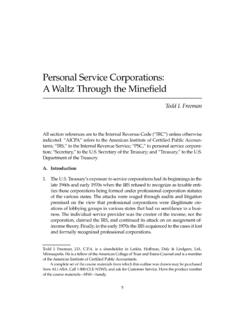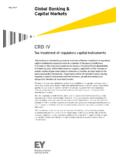Transcription of 1031 Exchanges - Larkin Hoffman
1 CHAPTER 14: 1031 exchanges Paul J. Linstroth Larkin Hoffman Daly & Lindgren, Ltd. Bloomington, Minnesota TABLE OF CONTENTS. GENERAL ..14-1. PROPERTY QUALIFYING FOR 1031 TREATMENT ..14-2. A. Specific Properties Not Qualifying Under 1031 ..14-2. B. Partnership Interests ..14-2. C. Purpose for Holding ..14-3. D. E. Examples of Properties Qualifying for 1031 Treatment ..14-4. F. Examples of Properties Not Qualifying ..14-6. G. Mixed-Use Property ..14-6. NON-QUALIFYING PROPERTY GIVEN AND RECEIVED ..14-7. BASIS IN PROPERTY RECEIVED ..14-9. MULTI-PARTY Exchanges ..14-10. DEFERRED Exchanges .. 14-11. A. Background .. 14-11. B. Identification and Receipt Requirements .. 14-11. 1. 1031(a)(3) .. 14-11. 2. Regulations .. 14-11. C. Receipt of Money or Other Property/Constructive Receipt and Agency ..14-14. 1. Common Law ..14-14. 2. Regulations ..14-14. D. Other Open Issues.
2 14-17. 1. Receipt and Payment of Earnest-Money Deposits ..14-17. 2. Replacement of Qualified Intermediary ..14-18. 3. Deferred exchange by a Partnership of Property Subject to Debt ..14-18. 4. Options ..14-19. REVERSE A. Revenue Procedure 2000-37 Safe Harbor ..14-19. B. Parking Transactions Outside of Revenue Procedure 2000-37;. IRS Technical Advice Memorandum 200039005 and Private Letter Ruling 200111025 ..14-21. 1. Alternative Reverse exchange Structures ..14-22. 2. Technical Advice Memorandum 200039005 ..14-22. 3. Private Letter Ruling 200111025 ..14-23. REPLACEMENT PROPERTY TO BE BUILT ..14-23. Exchanges INVOLVING PARTNERS AND PARTNERSHIPS ..14-24. A. Purchase of Partnership Interest ..14-24. B. Special Allocation ..14-24. C. Distribution of Undivided Interests ..14-25. TENANCY IN COMMON INTERESTS AND DELAWARE STATUTORY TRUSTS ..14-26. SELECT ISSUES REGARDING DEBT IN exchange TRANSACTIONS.
3 14-28. A. Pre- exchange Financing ..14-28. B. Post- exchange TABLE OF CONTENTS. C. Buyer Financing of Relinquished Property ..14-28. 1. Sell Note on Open Market ..14-29. 2. Transfer Buyer's Note to Seller of Replacement Property ..14-29. 3. Taxpayer Makes Loan to Buyer of Relinquished Property ..14-29. 4. Taxpayer Acquires Buyer's Note from Intermediary for Cash ..14-29. SPECIAL PURPOSE ENTITIES ..14-29. RELATED-PARTY Exchanges ..14-30. SPECIAL ISSUES ..14-31. A. Mixed-Use Properties Owner-Occupied Duplex, Farms and Home Business ..14-31. B. Vacation Homes, Time Shares as Replacement Property ..14-32. Exchanges AND OTHER INTERNAL REVENUE CODE SECTIONS ..14-32. A. Involuntary Conversions ..14-32. B. Passive Activity Losses ..14-32. C. Deemed Sale of Property in Connection with D. Withholding in Connection with Dispositions of Real Property by Foreigners.
4 14-32. CHAPTER 14 1031 exchanges GENERAL. CHAPTER 14. 1031 exchanges . GENERAL. 1031(a)(1) states: No gain or loss shall be recognized on the exchange of property held for productive use in a trade or business or for investment if such property is exchanged solely for property of like kind which is to be held either for productive use in a trade or business or for investment. An exchange qualifying under 1031 is technically not, as it is often called, a tax-free exchange ;. it is a deferred exchange , because recognition of the gain is deferred for tax purposes. The deferral of the gain is accomplished by having a deferred substituted adjusted tax basis in the replacement property. See infra As the statute states, there must be an exchange . A sale followed by an immediate investment in like-kind property does not fall within the scope of 1031. The taxpayer must not receive, directly or indirectly, the proceeds from the disposition of the property.
5 It has been said that this is the only formality required for an 1031 exchange . An exchange can involve multiple parties, often referred to as a three-corner exchange . For example, X wants to transfer his property to Y in an 1031 exchange , but Y does not own any property that X desires. Y can acquire property from Z who owns the property that X desires, and arrange for it to be transferred to X. A multi-party exchange does not have to be simultaneous. 1031(a)(3) contains rules for deferred Exchanges , some times referred to as Starker Exchanges after a 1979 Ninth Circuit case that permitted a nonsimultaneous exchange . 1031 is not elective. Where an exchange meets the requirements of 1031, nonrecognition will be afforded, even if the taxpayer desires that the transfer be taxable, or produce a loss. Thus, to have a taxable transaction, the transaction must fall outside 1031.
6 Gain is recognized to the extent that net cash and other nonqualified property, known as boot, is received. However, the amount of the gain recognized is limited to the gain realized. No loss can be recognized in a qualifying exchange . 1031(c). An exchange can be with a related party. However, any gain recognized may be ordinary income under 1239. Also, special rules exist under 1031(f) for Exchanges with related parties. These rules generally require that the unrecognized gain be recognized when either of the related parties disposes of the exchanged property within two years. 1031(f)(2) states that this rule will not apply to the following situations: after the earlier of the death of the taxpayer or the related person;. in a disposition resulting from a compulsory or involuntary conversion; or if it is established that neither the original exchange nor the subsequent disposition had as one of its principal purposes the avoidance of tax.
7 Exchanges must be reported on Form 8824, Like-Kind Exchanges . This form reports the computation of both the realized gain and the recognized gain. 14-1. GENERAL THE MINNESOTA REAL ESTATE PURCHASE & SALE DESKBOOK. A contract for sale can be amended prior to closing of the property to provide that an exchange is desired. See Alderson v. Comm'r, 317 790 (9th Cir. 1963); Coupe v. Comm'r, 52 394 (1969);. Borchard v. Comm'r, 24 1643 (1965). PROPERTY QUALIFYING FOR 1031 TREATMENT. A. Specific Properties Not Qualifying Under 1031. These include: stock in trade or other property held primarily for sale;. stocks, bonds, or notes;. other securities or evidences of indebtedness or interest;. interests in a partnership;. certificates of trust or beneficial interests;. choses in action (a personal right not reduced into possession, but recoverable by a suit at law or other right of action).
8 An exchange of real property located in the for real property located outside the 1031(a)(2) & (h)(1). B. Partnership Interests As noted above, 1031(a)(2)(D) specifically excludes interests in partnerships as property qualifying for exchange treatment under 1031(a). This restriction applies only to the exchange of interests in different partnerships. The exchange of interests in the same partnership is permitted. Revenue Ruling 84-52 allowed a partner to convert his general partnership interest into a limited partnership interest. This ruling is cited in the preamble to the 1031 regulations. 8346, 1991-1 150. Revenue Ruling 84-52 is cited by many of the numerous rulings permitting a partnership to convert to a limited liability company classified as a partnership for federal tax purposes. The flush language to 1031(a)(2) states, an interest in a partnership which has in effect a valid election under [ ] 761(a) to be excluded from the application of all of subchapter K shall be treated as an interest in each of the assets of such partnership and not as an interest in a partnership.
9 Under 761(a), only those partnerships that are formed under the following circumstances may elect out of subchapter K: (1) for investment purposes and not for the active conduct of a business, (2) for the joint production, extraction, or use of property, but not for the purpose of selling services or property produced or extracted, or (3) by dealers in securities for a short period for the purpose of underwriting, selling, or distributing a particular issue of securities. 14-2. CHAPTER 14 1031 exchanges PROPERTY QUALIFYING FOR 1031 TREATMENT. The exchange of membership interests in limited liability companies with two or more members, which are treated as partnerships for tax purposes, also would fall within the exclusion of 1031(a). (2)(D). C. Purpose for Holding To paraphrase 1031(a)(1), no gain or loss is recognized if property held for productive use in a trade or business or for investment is exchanged solely for property of a like kind to be held either for productive use in a trade or business or for investment.
10 Property held for productive use can be exchanged for property held for investment. For example, land held for investment can be exchanged for an office building held for rental. EXAMPLE. Converting non-depreciable property into depreciable property. Jim has some land with a basis of $800,000 and a fair market value of $1,000,000. He trades it and $300,000 in cash for an office building that has a fair market value of $1,300,000. Jim now has an asset with a depreciable base (ignoring the allocation of a portion of the basis to the land underlying the building) of $1,100,000. There is often a thin line between real property held for sale (which does not qualify) and real property held for investment (which does qualify). See Williford, Purpose for Which Real Property is Acquired and Held Affects the Tax Consequences of its Sale, 22 J. REAL EST. TAX'N 56 (1994).








